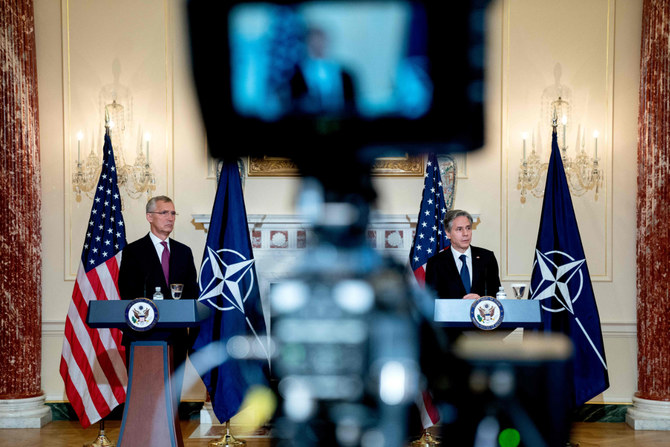
- ARAB NEWS
- 13 Jul 2025

The North Atlantic Treaty Organization (NATO) was founded in 1949 to protect the territorial integrity of its members and — if required — to defeat the Soviet Union in western Europe. While its members are no longer worried about the spread of communism, many are concerned about protecting their territory from Russian aggression.
Ever since the end of the Cold War in the early 1990s, NATO’s mission has been questioned on numerous occasions. The crisis in the Balkans and NATO’s intervention in Bosnia and Serbia in the second half of the 1990s gave the alliance new purpose in the post-Cold War world. The NATO-led military mission in Afghanistan after the 9/11 terrorist attacks forced the alliance to focus on “out of area” missions for almost two decades. However, Russia’s recent invasion of Ukraine has refocused the alliance on collective and territorial defense similar to its original 1949 mission.
Russia’s invasion of Ukraine has also brought the two age-old issues of defense spending (or lack thereof) by NATO members and the issue of NATO enlargement back into the spotlight.
As an intergovernmental security alliance, NATO is only as strong as its member states. Weak defense spending on the continent has led to a significant loss of capabilities and embarrassing gaps in readiness for NATO allies. Although most are familiar with Article 5 of the 1949 North Atlantic Treaty — an attack on one is an attack on all — Article 3 is the most important when it comes to the overall health of the alliance. It says that member states, at a minimum, will “maintain and develop their individual and collective capacity to resist armed attack.” Only a handful of NATO members can say that they are living up to their Article 3 commitment.
However, it is very likely that Russia’s actions in Ukraine will fundamentally change the way Europeans look at the issue of defense spending. Many NATO members have pledged to spend more on defense. For example, Chancellor Schölz announced Germany would now commit to spending the NATO target of 2 percent of GDP on defense, stating that “we will need to invest a lot more in the security of our country to defend our freedom and our democracy.” It was also announced that Germany will create a €100 billion ($107 billion) special defense fund in the 2022 budget to help attain the goal of reaching 2 percent of GDP on defense. Before Russia’s recent invasion of Ukraine this would have been unheard of.
Another issue getting a lot of attention is NATO enlargement.
There is no doubt that Russia’s invasion of Ukraine has completely altered the geopolitical landscape of the transatlantic community. For the first time since the Cold War, NATO’s mission and purpose has never been clearer. The unity and cohesion of the alliance has never been greater.
Luke Coffey
NATO’s “open-door” policy has been a crucial driver of modernization and reform in candidate countries. It has promoted stability and peace in Europe and has made it easier for the alliance to coalesce around collective defense. Article 10 of the 1949 North Atlantic Treaty says that any European state that is “in a position to further the principles of this treaty and to contribute to the security of the North Atlantic area” can be invited to join the alliance.
The open-door policy for qualified countries has contributed greatly to transatlantic security since the first round of enlargement in 1952, helping to ensure the alliance’s central place as the prime guarantor of security in Europe.
An alliance that started with 12 members now totals 30 thanks to several successful rounds of enlargement. However, in recent years, the pace of adding new members has slowed down. Russia often claims that NATO enlargement is a threat, but the facts do not show this to be the case. Since 2005, only four new members have been added to the alliance. All four of which are located in the Balkans more than 1200 km away from the Russian border.
Some point to the possibility of Ukrainian membership as the reason, if not the justification, for Russia’s invasion of Ukraine. Yes, Ukraine was promised eventual membership in 2008. But in reality, on Feb. 24, 2002 Ukraine was never close to joining the Alliance. Kyiv knew this. Moscow knew this. Anyone watching geopolitical developments in eastern Europe knew this. It is also worth remembering that when Russia first invaded Ukraine in 2014 and annexed Crimea, the invasion was in reaction to Kyiv signing an Association Agreement with the EU. At the time it had nothing to do with NATO.
There is no doubt that Russia’s invasion of Ukraine has completely altered the geopolitical landscape of the transatlantic community. For the first time since the Cold War, NATO’s mission and purpose has never been clearer. The unity and cohesion of the alliance has never been greater. The desire of European countries which are not already NATO members to join the alliance has never been stronger.
Over three months ago, Russia invaded Ukraine with the belief that Kyiv would be captured in a matter of days and NATO would fail to respond in any meaningful way. Instead, NATO has rallied around support for Ukraine’s self-defense and NATO has never been more united. Russia is now weaker than at any time in recent history and Moscow has nobody else to blame but itself.
• Luke Coffey is the director of the Douglas and Sarah Allison Center for Foreign Policy at the Heritage Foundation. Twitter: @LukeDCoffey